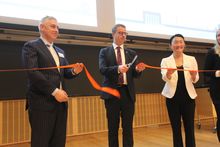Time for the big vannkraftutbyggingene is in my view not the past, ” said energy minister Terje Søviknes (Frp) when he Monday opened Norway’s new large-scale initiative on vannkraftforskning in Trondheim, norway, research centre HydroCen.
the Center is in the Two FME-scheme (Research center for eco-energy), and has received a budget of almost 400 million over up to eight years.
In his opening speech gave the fresh energy minister allowed many words of praise.
the Backbone of the energy system
In Norway we have maybe taken allowed a little for granted, especially through the last forty, fifty years when everything has been focused on oil and gas. But allowed is the backbone of the energy system, and it shall also be in the future, elaborates on the Søviknes opposite Teknisk Ukeblad.
He believes HydroCen will put allowed on the agenda again.
” It is important, since the need for investment and upgrades in vannkraftsektoren is great, because many of the power plants were built in the 1950′s, -60, and -70′s. One can extract much more power with modern technology, ” says Søviknes.
- Verneplanen is located where
energy minister, however, did not elaborate on what the “big vannkraftutbygginger” he would be willing to give byggingstillatelse to, and about, for example, Vefsna could be one of them.
 Energy minister Terje Søviknes cuts the cord and open the HydroCen in Trondheim. He is assisted by the centre’s chairman of the board Ivar Arne Børset and general manager Hege Brende. Photos: Øyvind Lie
Energy minister Terje Søviknes cuts the cord and open the HydroCen in Trondheim. He is assisted by the centre’s chairman of the board Ivar Arne Børset and general manager Hege Brende. Photos: Øyvind Lie
- I shall not go into details. We have a protection plan that is there. But there are many medium-sized power plants, which today are under development and several are located to the licensing process. In our world defined this as “large hydropower”, in the sense that there is much of it which is adjustable and which is defined as large in konsesjonssystemet, ” he says.
NTNU is vertsinstitusjon and hovedforskningspartner in HydroCen together with Sintef Energy and the Norwegian institute for nature research (NINA). HydroCen has around 50 national and international partners from research, industry, and government.
the Centre will conduct research on both vannkraftkonstruksjoner, turbine and generator market and services and ecodesign.
Half of the funds to HycroCen comes from the Research council of norway, while the centre’s brukerpartnere (within business and management) and research partners pay a quarter each.
- renaissance
HydroCens leader Hege Brende says to Teknisk Ukeblad is says she is extremely happy for the mobilization that is now happening within the vannkraftforskningen.
” This is a milestone. For the old NTH, the technical bedrock of education in Norway, this is a renaissance, ” she says to Teknisk Ukeblad.
the biggest difference from The earlier, according to the Burnt that researchers now no longer work as isolated.
- The new platform we have now, means we get a long-term and comprehensive commitment, ” she says.
Money should not be used to build new laboratories.
” We’re not going to build something new, but we are going to upgrade and expand existing infrastructure. Work is essential to drive the development of technology, ” says Brende.
Also, much of the money go to the research fellows and new appointments.
- We need a boost to get built up again travel, ” she says.
- Hydropower cheaper than the sun
water Resources and energidirektør Per Sanderud estimated in his speech that even though solar power is increasingly being cheaper, is levetidskostnaden still two to three times higher than allowed. HydroCens research should, according to the Sanderud do allowed even cheaper.
He will not, however, have some may well idea of whether or not the big vannkraftutbyggingers time is passing or not.
- there Is a potential in Norway for large vannkraftutbygginger?
- Yes, there is. But the protected rivers are protected, that we take as given. As there are some other that have a certain size as it is possible to get taken advantage of. But I don’t think the potential is huge, ” he says to Teknisk Ukeblad.
He emphasizes, however, that there still are good projects for an upgrade of the hydroelectric power plants that can boost production, and refers to the Nedre Røssåga as a good example.
No comments:
Post a Comment